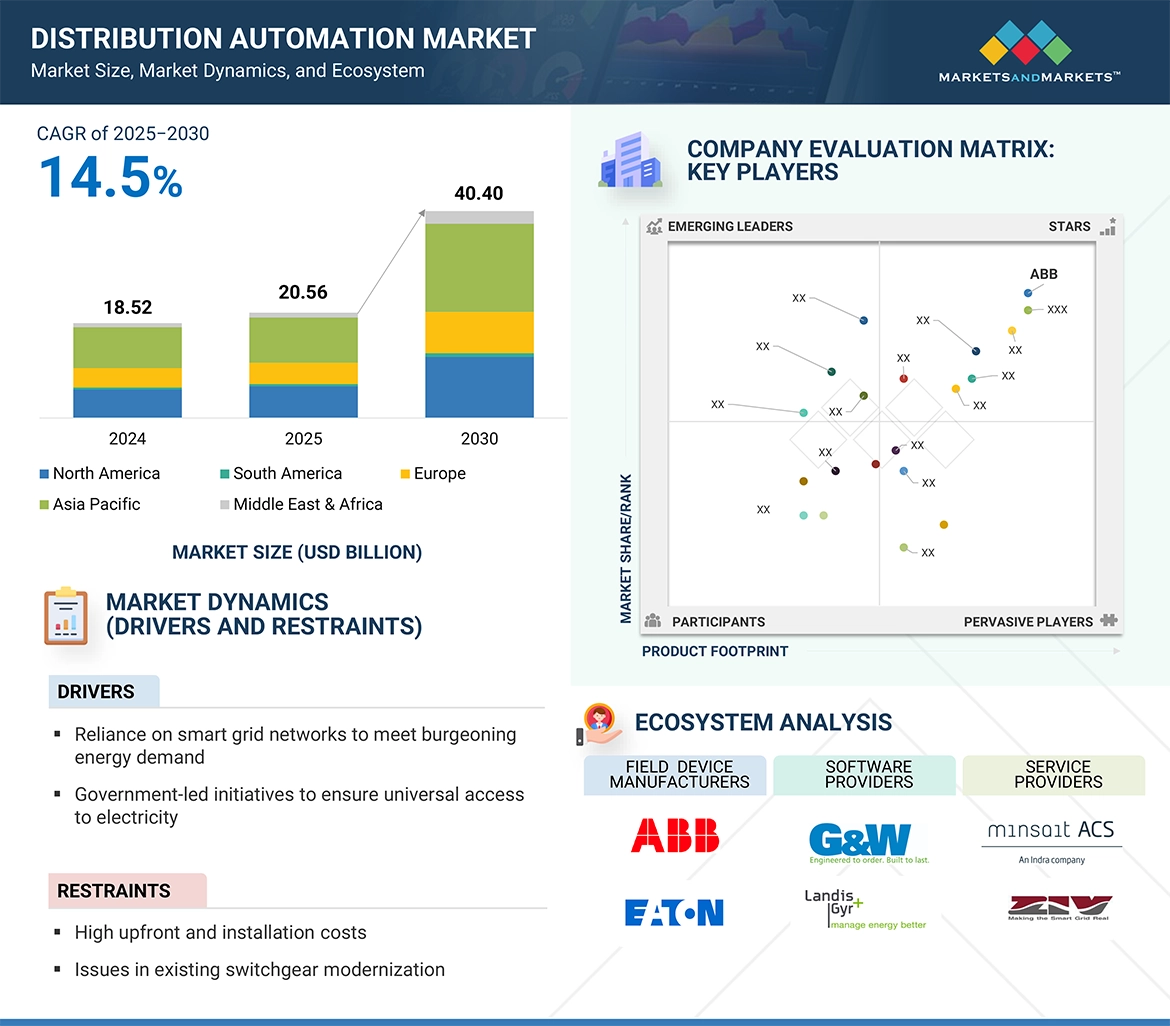According to a research report “Distribution Automation Market by Offering (Field Devices, Software, Services), Communication Technology (Wired (Fiber Optic, Ethernet, Powerline Carrier, IP), Wireless), Utility (Public Utilities, Private Utilities), and Region – Global Forecast to 2030″, the global distribution automation market is estimated to be valued at USD 20.56 billion in 2025 and is projected to reach USD 40.40 billion by 2030, growing at a CAGR of 14.5% during the forecast period. The Distribution automation market is expanding rapidly due to the global shift towards improved and more robust power grids. There is increased expenditure on grid modernization, including renewable energy sources, and there is increased demand for real-time information and control. This is enabling more individuals to utilize distribution automation technologies.
Advances in communications infrastructure, artificial intelligence, and the Internet of Things are making systems more efficient, detecting faults, and providing energy reliability. Utilities are increasingly applying more automation to reduce the duration of outages, lower costs, and improve energy transmission. Also, government programs and policies enabling the expansion of smart grids are helping market expansion, particularly in developing nations.
Download PDF Brochure – https://www.marketsandmarkets.com/pdfdownloadNew.asp?id=65029172
The field devices segment to dominate the distribution automation market, by offering, during the forecast period
The distribution automation market, by offering, is divided into field devices and software & services. With respect to the distribution automation market, the field devices sector is the larger segment. Field devices will most likely enjoy the larger market share in the distribution automation market since they play a crucial role in real-time monitoring, control, and automation of the power distribution grid. Smart sensors, automatic switches, reclosers, and voltage regulators are the most important factors in making the grid more reliable, reducing outage duration, and enhancing fault detection and isolation. As utilities continue to upgrade their systems, the need for smart field equipment that enables remote operation and seamless communication with central control systems is on the rise.

Wireless to witness a faster growth rate in the distribution automation market, by communication technology, during the forecast period
The distribution automation market, by communication technology, is divided into wired and wireless. Wireless communications technology will develop most rapidly in the distribution automation market, surpassing wired systems due to its flexibility, easy scalability with minimal effort, and affordability. In contrast to wired systems, wireless networks can be rapidly installed without the necessity of extensive physical infrastructure. This makes them ideal for retrofitting legacy grids and reaching remote or hard-to-reach locations. Increasing amounts of smart sensors, IoT devices, and mobile workforce solutions are driving the demand for reliable wireless communication. Further, technology advancements in 5G, LPWAN, and mesh networks have significantly improved data speed, delay, and security, making wireless systems the preferred choice for real-time monitoring and control in advanced distribution networks.
Private utilities to witness the faster growth rate in the distribution automation market, by utility, during the forecast period
The distribution automation market, by utility, is divided into private utilities and public utilities, wherein the public segment accounts for the larger share. Private utilities are likely to expand faster in the distribution automation market. They can make investments more freely, embrace new technologies rapidly, and excel in operating efficiently. Private firms are usually subject to competitive pressures and desire profitability. This compels them to modernize their systems rapidly and employ automation solutions that enhance reliability, reduce downtime, and enhance the distribution of energy. Furthermore, since more emphasis is being placed on utilizing renewable power, strengthening the grid, and treating customers well, private utilities are employing digital technologies such as AI, IoT, and advanced analytics more intensively.
Middle East & Africa to be the fastest-growing distribution automation market during the forecast period
In this report, the distribution automation market has been analyzed for five regions, namely, Asia Pacific, North America, Europe, South America, and the Middle East & Africa. The Middle East & Africa market is evolving as the fastest-growing distribution automation market due to rapid urbanization, increasing electricity consumption, and massive investment in the development of the power grid. Saudi Arabia and the UAE are the leading countries investing heavily in innovative distribution automation technology to have a more robust and efficient power grid. The region’s emphasis on decentralized power generation from renewable energy sources, such as solar and wind, necessitates intelligent automation systems to manage the challenges of decentralized power generation.
Ask Sample Pages of the Report – https://www.marketsandmarkets.com/requestsampleNew.asp?id=65029172
Some of the major players in the distribution automation market are ABB (Switzerland), Schneider Electric (France), Siemens (Germany), Eaton (Ireland), and GE Vernova (US). Other major players include S&C Electric Company (US), Toshiba (Japan), Landis+Gyr (Switzerland), Itron Inc. (US), Hubbell (US), Xylem (US), Schweitzer Engineering Laboratories, Inc. (US), and G&W Electric (US). The major strategies adopted by these players include product launches, contracts, agreements, investments, partnerships, and expansions.
